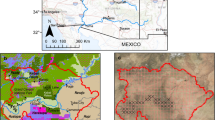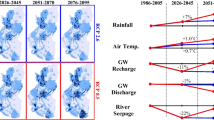Abstract
We evaluated the past impacts of urbanization and climate change on groundwater—in particular, aquifer temperature—in the Sendai plain, Japan, and further compared with the probable changes due to changing climate in the future. A series of simulations were performed and matched with the observed temperature-depth profiles as a preliminary step for parameter calibration. The magnitude of ground surface warming estimated from subsurface temperature spans 0.9–1.3°C, which is consistent with the calibrated ground surface warming rates surrounding various observation wells (0.021–0.015°C/year) during the last 60 years. We estimate that approximately 75% of the ground surface temperature change can be attributed to the effect of past urbanization. For the climate predictions, climate variables produced by the UK Hadley Centre’s Climate Model (HadCM3) under the A2, A1B and B1 scenarios were spatially downscaled by the transfer function method. Downscaled monthly data were used in a water budget analysis to account for the variation in recharge and were further applied in a heat transport equation together with the estimated ground surface warming rates in 2080. Anticipated groundwater recharge under the projected climate in 2080 would decrease by 1–26% compared to the 2007 estimates, despite the projected 7–28% increase in precipitation, due to a higher degree of evapotranspiration resulting from a 2.5–3.9°C increase in surface air temperature. The overall results from the three scenarios predict a 1.8–3.7°C subsurface temperature change by 2080, which is notably greater than the previous effect of urbanization and climate change on aquifer temperature in the Sendai plain.
Similar content being viewed by others
References
Anderson Jr WP, Anderson JL, Thaxton CS, Babyak CM (2010) Changes in stream temperatures in response to restoration of groundwater discharge and solar heating in a culverted, urban stream. J Hydrol 393:309–320
Arora VK (2002) The use of the aridity index to assess climate change effect on annual runoff. J Hydrol 265:164–177
Baker DG, Ruschy DL (1993) The recent warming in eastern Minnesota shown by ground temperatures. Geophys Res Lett 20:371–374
Beltrami H, Kellman L (2003) An examination of short- and long-term air–ground temperature coupling. Global Planet Change 38:291–303
Bense V, Beltrami H (2007) Impact of horizontal groundwater flow and localized deforestation on the development of shallow temperature anomalies. J Geophys Res 112:F04015. doi:10.1029/2006JF000703
Born SM, Genskow KD, Filbert TL, Hernandez-Mora N, Keefer ML, White KA (1998) Socioeconomic and institutional dimensions of dam removals: the Wisconsin experience. Environ Manag 22:359–370
Brunke M, Gonser T (1997) The ecological significance of exchange processes between rivers and groundwater. Freshwater Biol 37:1–33
Carslaw HS, Jaeger JC (1959) Conduction of heat in solids, 2nd ed. Oxford University Press, New York
Chen Z, Stephen E, Osadetz KG (2002) Predicting average annual groundwater levels from climate variables: an empirical model. J Hydrol 260:102–117
Drake J, Bradford A, Joy D (2010a) A multi-scale method for identifying groundwater exchanges sustaining critical thermal regimes in streams. Int J River Basin Manag 8:173–184
Drake J, Bradford A, Joy D (2010b) Application of HEC-RAS 4.0 temperature model to estimate groundwater contributions to Swan Creek, Ontario, Canada. J Hydrol 389:390–398
Eaton JG, Scheller RM (1996) Effects of climate warming on fish thermal habitat in streams of the United States. Limnol Oceanogr 4l:1109–1115
Ferguson G, Woodbury AD (2004) Subsurface heat flow in an urban environment. J Geophys Res 109(B2):B02402. doi:10.1029/2003JB002715
Ferguson G, Woodbury AD (2005) The effect of climatic variability on estimates of recharge derived from temperature data. Ground Water 43:937–842
Ferguson G, Woodbury AD, Matile GLD (2003) Estimating deep recharge rates beneath an interlobate moraine using temperature logs. Ground Water 41:640–646
Geological Survey of Japan AIST (2004) Water Environmental Map No. 1 Sendai Plain, Geological Survey of Japan AIST
Gitay H, Brown S, Easterling W, Jallow B (2001) Ecosystems and their goods and services. Climate change (2001) Impacts adaptation, and vulnerability. In: McCarthy JJ, Canziani OF, Leary NA, Dokken DJ, White KS (eds) Contribution of Working Group II to the Third Assessment Report of the Intergovernmental Panel on Climate Change. Cambridge University Press, Cambridge
Glugla G, Krahe P (1995) Abflußbildung in urbanen Gebieten (Runoff formation in urban areas). Document series, Hydrologie/Wasserwirtschaft 14, Ruhr University of Bochum 140–160
Glugla G, Müller E (1997) Grundwasserneubildung als Komponente der Abflussbildung (New groundwater formation as a component of runoff formation). In: Leibundgut C, Demuth S (eds.) Grundwasserneubildung (New groundwater formation). Freiburger Schriften zur Hydrologie, Band 5:23–35
Gunawardhana LN, Kazama S (2009) Tidal effects on aquifer thermal regime: An analytical solution for coastal ecosystem management. J Hydrol 377:377–390
Gunawardhana LN, Kazama S (2011) Climate change impacts on groundwater temperature change in the Sendai plain, Japan. Hydrol Process. doi:10.1002/hyp.8008
Hansen J, Lebedeff S (1987) Global trends of measured surface air temperature. J Geophys Res 92:13345–13372
Huang S, Pollack HN, Shen PY (2000) Temperature trends over the past five centuries reconstructed from borehole temperatures. Nature 403:756–758
IPCC (2007) Summary for Policymakers. In: Parry ML, Canziani OF, Palutikof JP, van der Linden PJ, Hanson CE (eds) Climate Change 2007: Impacts, Adaptation and Vulnerability. Contribution of Working Group II to the Fourth Assessment Report of the Intergovernmental Panel on Climate Change. Cambridge University Press, Cambridge
Jones ML, Shuter BJ, Zhao Y, Stockwell JD (2006) Forecasting effects of climate change on Great Lakes fisheries: models that link habitat supply to population dynamics can help. Can J Fish Aquat Sci 63:457–468
Kang JH, Kazama S (2010) Assessment and Correlation between the Physical Habitat and Species Diversity of Benthos in Mountain Stream with Slit Dam. 6th International Symposium on Environmental Hydraulics: Greece
Kazama S, Matsumoto S, Ranjan SP, Hamamoto H, Sawamoto M (2007) Characterization of firefly habitat using a geographical information system with hydrological simulation. Ecol Model 209:392-400
Kipkorir EC, Raes D, Massawe B (2002) Seasonal water production functions and yield response factors for maize and onion in Perkerra, Kenya. Agric Water Manag 56:229–240
Li XY, Xu HY, Sun YL, Zhang DS, Yang ZP (2007) Lake-Level Change and Water Balance Analysis at Lake Qinghai, West China during Recent Decades. Water Res Manag 21:1505–1516
Lu N, Ge S (1996) Effect of horizontal heat and fluid flow on the vertical temperature distribution in a semiconfining layer. Water Resour Res 32:1449–1453
Majorowicz JA, Skinner WR (1997) Potential causes of differences between ground and surface air temperature warming across different ecozones in Alberta, Canada. Global Planet Change 15:79–91
Majorowicz J, Grasby SE, Ferguson G, Safanda J, Skinner W (2006) Paleoclimatic reconstructions in western Canada from borehole temperature logs: surface air temperature forcing and groundwater flow. Clim Past 2:1–10
Mann ME, Schmidt GA (2003) Ground vs. surface air temperature trends: Implications for borehole surface temperature reconstructions. Geophys Res Lett 30:1607. doi:10.1029/2003GL017170
Nitoiu D, Beltrami H (2005) Subsurface thermal effects of land use changes. J Geophys Res 110:F01005. doi:10.1029/2004JF000151
Pollack HN, Huang S (1998) Underground temperatures reveal changing climate. Geotimes 43:16–19
Putnam SN, Chapman DS (1996) A geothermal climate change observatory: first year results from Emigrant Pass in Northwest Utah. J Geophys Res 101:21 877–21 890
Quigley TM, Arbelbide SJ (1997) An assessment of ecosystem components in the interior Columbia basin and portions of the Klamath and Great basins. USDA Forest Service Pacific Northwest Research Station General Technical Report PNW-GTR-405, Vol. 3.
Randhir TO, Hawes AG (2009) Watershed land use and aquatic ecosystem response: Ecohydrologic approach to conservation policy. J Hydrol 364:182–199
Ranjan SP, Kazama S, Sawamoto M (2006) Effects of climate and land use changes on groundwater resources in coastal aquifers. J Environ Manag 80:25–35
Rayne S, Henderson G, Gill P, Forest K (2008) Riparian Forest Harvesting Effects on Maximum Water Temperatures in Wetland-sourced Headwater Streams from the Nicola River Watershed, British Columbia, Canada. Water Resour Manag 22:565–578
Reiter M (2001) Using precision temperature logs to estimate horizontal and vertical flow components. Water Resour Res 37:663–674
Reiter M (2006) Vadose zone temperature measurements at a site in the northern Albuquerque Basin indicate ground-surface warming due to urbanization. Environ Eng Geosci 12:353–360
Reiter M (2007) Variability of recent ground surface temperature changes in the Albuquerque basin, central New Mexico. J Geophys Res 112:D24S07. doi:10.1029/2006JD008215
Salathe EP Jr, Mote WP (2007) Review of scenario selection and downscaling methods for the assessment of climate change impacts on hydrology in the United States Pacific Northwest. Int J Clim 27:1611–1621
Scanlon BR, Healy RW, Cook PG (2002) Choosing appropriate techniques for quantifying groundwater recharge. Hydrogeol J 10:18–39
Schmidt WL, Gosnold WD, Enz JW (2001) A decade of air–ground temperature exchange from Fargo, North Dakota. Global Planet Change 29:311–325
Shuttleworth WJ (1992) Evaporation. In: Maidment DR (ed) Handbook of Hydrology. McGraw-Hill, New York, pp 4.1–4.53
Solman SA, Nunez MN (1999) Local estimates of global climate change: a statistical downscaling approach. Int J Climatol 19:835–861
Stallman RW (1965) Steady one-dimensional fluid flow in a semi-infinite porous medium with sinusoidal surface temperature. J Geophys Res 70:2821–2827
Steenhuis TS, Winchell M, Rossing J, Zollweg JA, Walter MF (1995) SCS runoff equation revised for variable source runoff areas. J Irrig Drain Eng, ASCE 121/3:234–238
Taniguchi M (1994) Estimated recharge rates from groundwater temperatures in the Nara basin, Japan. Hydrogeol J 2:7–14
Taniguchi M (2006) Anthropogenic effects on subsurface temperature in Bangkok. Clim Past Disc 2:831–846
Taniguchi M (2007) Combined effects of urbanization and global warming on subsurface temperatures in four Asian cities. Vadose Zone J 6:591–596
Taniguchi M, Shimada J, Tanaka T et al (1999a) Disturbances of temperature–depth profiles due to surface climate-change and subsurface water flow: (1) An effect of linear increase in surface temperature caused by global warming and urbanization in the Tokyo metropolitan area, Japan. Water Resour Res 35:1507–1517
Taniguchi M, Williamson DR, Peck AJ (1999b) Disturbances of temperature–depth profiles due to surface climate-change and subsurface water flow: (2) an effect of step increase in surface temperature caused by forest clearing in southwest of Western Australia. Water Resour Res 35:1519–1529
Taniguchi M, Turner JV, Smith AJ (2003) Evaluations of groundwater discharge rates from subsurface temperature in Cockburn Sound, Western Australia. Biogeochem 66:111–124
Trabucco A, Zomer RJ, Bossio DA, Straaten OV, Verchot LV (2008) Climate change mitigation through afforestation/reforestation: a global analysis of hydrologic impacts with four case studies. Agric Ecosyst Environ 126:81–97
Tsutsumi A, Jinno K, Berndtsson R (2004) Surface and subsurface water balance estimation by the groundwater recharge model and a 3-D two-phase flow model. Hydrol Sci J 49:205–226
Uchida Y, Hayashi T (2005) Effects of hydrogeological and climate change on the subsurface thermal regime in the Sendai Plain. Phys Earth Planet Inter 152:292–304
US Department of Agriculture, Soil Conservation Service (1972) Hydrology, Nattional Engineering Handbook, Section 4. US Government Printing Office, Washington, DC, pp 10.1-10.24
Widmann M, Bretherton CS, Salathe EP (2003) Statistical precipitation downscaling over the northwestern United States using numerically simulated precipitation as a predictor. J Clim 16:799–816
Winter T, Harvey JW, Franke OL, Villiam MA (1998) Ground Water and Surface Water—A Single Resource. U.S. Geol Surv Circ 1139:9–17
Wood AW, Leung R, Sridhar V et al (2004) Hydrologic implications of dynamical and statistical approaches to downscaling climate model outputs. Clim Change 62:189–216
Zhang XC (2005) Spatial downscaling of global climate model output for site-specific assessment of crop production and soil erosion. Agricu For Meteorol 135:215–229
Author information
Authors and Affiliations
Corresponding author
Rights and permissions
About this article
Cite this article
Gunawardhana, L.N., Kazama, S. & Kawagoe, S. Impact of Urbanization and Climate Change on Aquifer Thermal Regimes. Water Resour Manage 25, 3247–3276 (2011). https://doi.org/10.1007/s11269-011-9854-6
Received:
Accepted:
Published:
Issue Date:
DOI: https://doi.org/10.1007/s11269-011-9854-6




